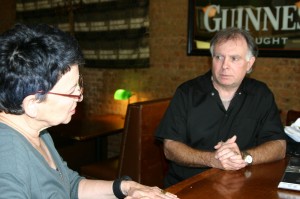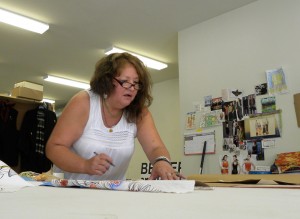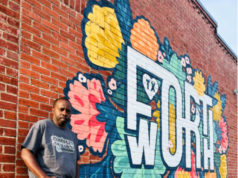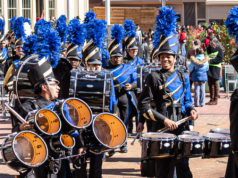In 2005, the city designated Six Points as an urban village with a focus on Race Street and the Six Points intersection, where the historic McAdams building stands. The building, once slated for demolition, became a catalyst for renewal.

The Six Points project began with a lot of steam in 2005. The federal government contributed $790,000 for streetscape and intersection improvements, and the Fort Worth City Council approved using $50,000 of that to develop a plan that would bring dining, shopping, and entertainment within walking distance of residents’ homes. Streetlights and bike lanes were included. The plan envisioned Six Points as a smaller version of the Magnolia Avenue arts district. Ideas flowed and enthusiasm peaked.
Then … nothing.
“It seemed like for a while there everything leveled out and nobody was quite sure what was going on,” Oakhurst Neighborhood Association vice president Libby Willis said. “Once the master plan for the urban village was completed by the city, we no longer really had a city staff person assisting the advisory committee, and those meetings stopped.”
The onus fell back on the property owners to take the lead, but many had already closed up shop. More than a half-dozen buildings sat vacant on Race Street’s short stretch of commercial district.
Willis harked back to a meeting in 2005 when more than 200 people turned out to talk about the future of Riverside. It was clear then, she said, that the key is to attract new businesses that fit the neighborhood’s wish list — a mixture of local, homegrown businesses and chain retail.
“It comes down to the people who own the buildings, and it’s their decision what they put in those,” Willis said.
She sees recent activity, such as Race Street’s inclusion in Gallery Night in September, as a fresh sign of life. Sometimes it just takes time for all the moving parts to come together, she said, recalling the many years that passed before the Magnolia urban village took root.
“Everybody thinks we have a bunch of restaurants on Magnolia and it’s just now getting going, but the seeds have been planted for 30 years,” she said. “Things don’t decline overnight, and they don’t come back overnight. Everybody wants to see every single property revitalized and opened tomorrow, but it doesn’t work that way.”
She offered further proof that Race redevelopment is moving forward — both Fuzzy’s and Mamma Mia’s survived the worst of the recession and continue to be successful.
“If you hang in there three to five years, it’s a sign that something is going right,” she said. “When you have 25 people coming out on a Saturday morning, and it’s hot and they’re willing to work, that tells you there is some kind of new interest that is pulling them out.”

The city spent $50,000 of the federal grant on developing a plan. Nearly five years later, not another penny has been spent nor a stripe painted on the street. Assistant City Manager Fernando Costa attributes the delay mainly to one thing: More money is needed, beyond the remaining $740,000 in federal funds, to accomplish the infrastructure improvements on Race Street and the Six Points intersection.
“It’s fair to say that this is a relatively small amount of funds for the magnitude of the needs,” he said.
Costa said planners have estimated the total cost of implementing the streetscape plan at “a few million dollars.”
City and federal dollars, combined with strong interest from residents and developers, have boosted other urban villages such as Magnolia Avenue and West Seventh Street, designed to revitalize close-in neighborhoods as an alternative to sprawl. On Race, the interest is there, but the dollars are dragging.
“Projects tend to proceed at different rates. It’s hard to draw direct comparisons, but we are making progress,” he said. “[Six Points] is not as dramatic and flashy like others, but it has a character of its own.”
With official redevelopment plans going nowhere, other improvements are also stalled. For example, a city program to install public art at the intersection can’t continue until the streets and sidewalks are renovated.
Meanwhile grassroots plans are forging ahead to give Six Points a facelift.
********












As long as there are gang bangers, people raising bait dogs for their dog fights, guns being blasted at all hours of the night, a total garbage school district, neighbors who could care less, people afraid or too stupid to call the police, high school kids yelling racial slurs and getting beat up in daylight, a culture of ignorance, poverty, lack of any sort of community even with next door neighbors, slum lords, elderly hold outs delusional about the quality of this neighborhood in respects to property value, neighbors respects for their own property and others, stupid neighbors disregards for city laws and codes, etc . . . this neighborhood will always be what it is: Oakhurst surrounded by crap.
Well, geez! Why don’t you just leave if it is too “crazy” for you and and the rest of us will just wait for Debby Stein to gentrify the neighborhood. Revitilizing this area by reinvesting in it will raise the property taxes enough to move all these elements out eventually so just be patient and praise the artistic elements moving in. We can just throw a block party for the artists to peek thier interests and charge them exorbitant amounts to be here and it will work great for eveyone! The artists are the first wave, the shock troops if you will, to move in and bring their mind sets of how things ought to be. They will demand more police actions and other city services and then property taxes will increase and rent on residential and commercial properties will as well so the property owners in the area will benefit the most. So, if you can just wait and snatch up as much property as you can in the area OUR UTOPIA will happen! Be patient!